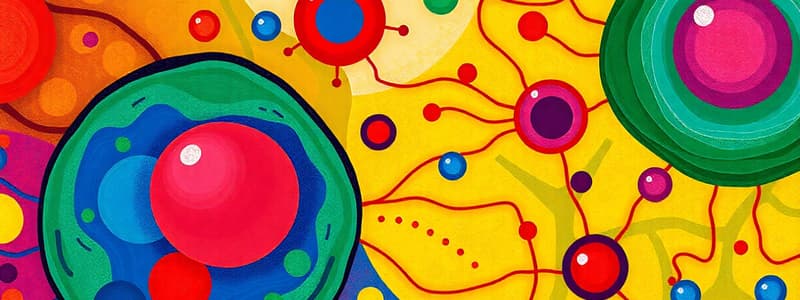Podcast
Questions and Answers
Who was the first scientist to observe cells under a microscope?
Who was the first scientist to observe cells under a microscope?
- Antonie van Leeuwenhoek
- Louis Pasteur
- Charles Darwin
- Robert Hooke (correct)
An Amoeba is a multicellular organism.
An Amoeba is a multicellular organism.
False (B)
What shapes can cells have within an organism?
What shapes can cells have within an organism?
Cells can have various shapes like polygonal or round.
Cells are classified as unicellular or __________ organisms.
Cells are classified as unicellular or __________ organisms.
Match the following types of organisms with their characteristics:
Match the following types of organisms with their characteristics:
Which of the following organisms is unicellular?
Which of the following organisms is unicellular?
The smallest cell, known as mycoplasma, is larger than a red blood cell.
The smallest cell, known as mycoplasma, is larger than a red blood cell.
What is the primary function of a nerve cell?
What is the primary function of a nerve cell?
Which organelle is known as the 'powerhouse of the cell'?
Which organelle is known as the 'powerhouse of the cell'?
The largest cell is the ______, which is nearly 170 mm in diameter.
The largest cell is the ______, which is nearly 170 mm in diameter.
Match the following cell types with their descriptions:
Match the following cell types with their descriptions:
The cytoplasm is located between the nuclear membrane and the cell membrane.
The cytoplasm is located between the nuclear membrane and the cell membrane.
What structure surrounds all living cells and regulates the entry and exit of substances?
What structure surrounds all living cells and regulates the entry and exit of substances?
The organelles responsible for photosynthesis in plant cells are called ______.
The organelles responsible for photosynthesis in plant cells are called ______.
Match the following cell organelles with their functions:
Match the following cell organelles with their functions:
What is the primary function of mitochondria in a cell?
What is the primary function of mitochondria in a cell?
Chloroplasts are responsible for storing starch in plant cells.
Chloroplasts are responsible for storing starch in plant cells.
What is the control center of the cell that contains genetic material?
What is the control center of the cell that contains genetic material?
The green plastids responsible for photosynthesis are called ______.
The green plastids responsible for photosynthesis are called ______.
What structure provides a definite shape to plant cells?
What structure provides a definite shape to plant cells?
Animal cells possess plastids.
Animal cells possess plastids.
What are large vacuoles primarily responsible for in plant cells?
What are large vacuoles primarily responsible for in plant cells?
Animal cells contain a flexible __________ that allows for a variety of shapes.
Animal cells contain a flexible __________ that allows for a variety of shapes.
What is the correct order of levels of organization in multicellular organisms?
What is the correct order of levels of organization in multicellular organisms?
Plant cells have a flexible cell wall.
Plant cells have a flexible cell wall.
What is the primary function of ribosomes?
What is the primary function of ribosomes?
In unicellular organisms like Amoeba, the single cell is responsible for functions such as capturing food, respiration, and __________.
In unicellular organisms like Amoeba, the single cell is responsible for functions such as capturing food, respiration, and __________.
Match the following structures with their primary characteristics:
Match the following structures with their primary characteristics:
Flashcards
Unicellular organisms
Unicellular organisms
Organisms made up of a single cell.
Multicellular organisms
Multicellular organisms
Organisms composed of many cells working together.
Cell Size and Shape
Cell Size and Shape
Cells can vary in size and shape depending on their function.
PPLO (Pleuro-pneumonia-like organism)
PPLO (Pleuro-pneumonia-like organism)
Signup and view all the flashcards
Ostrich egg
Ostrich egg
Signup and view all the flashcards
What are cells?
What are cells?
Signup and view all the flashcards
What is a unicellular organism?
What is a unicellular organism?
Signup and view all the flashcards
What is a multicellular organism?
What is a multicellular organism?
Signup and view all the flashcards
How do cells vary in size?
How do cells vary in size?
Signup and view all the flashcards
How do cells vary in shape?
How do cells vary in shape?
Signup and view all the flashcards
Cell membrane
Cell membrane
Signup and view all the flashcards
Cytoplasm
Cytoplasm
Signup and view all the flashcards
Nucleus
Nucleus
Signup and view all the flashcards
Mitochondria
Mitochondria
Signup and view all the flashcards
Endoplasmic Reticulum (ER)
Endoplasmic Reticulum (ER)
Signup and view all the flashcards
What is the cytoplasm?
What is the cytoplasm?
Signup and view all the flashcards
What is the nucleus's function?
What is the nucleus's function?
Signup and view all the flashcards
What are plastids?
What are plastids?
Signup and view all the flashcards
What function do mitochondria have?
What function do mitochondria have?
Signup and view all the flashcards
What is the endoplasmic reticulum (ER)?
What is the endoplasmic reticulum (ER)?
Signup and view all the flashcards
Tissue
Tissue
Signup and view all the flashcards
Organ
Organ
Signup and view all the flashcards
Organ system
Organ system
Signup and view all the flashcards
Vacuole
Vacuole
Signup and view all the flashcards
Ribosomes
Ribosomes
Signup and view all the flashcards
What is the cell wall?
What is the cell wall?
Signup and view all the flashcards
What are vacuoles?
What are vacuoles?
Signup and view all the flashcards
What is the cell membrane?
What is the cell membrane?
Signup and view all the flashcards
What is cytoplasm?
What is cytoplasm?
Signup and view all the flashcards



